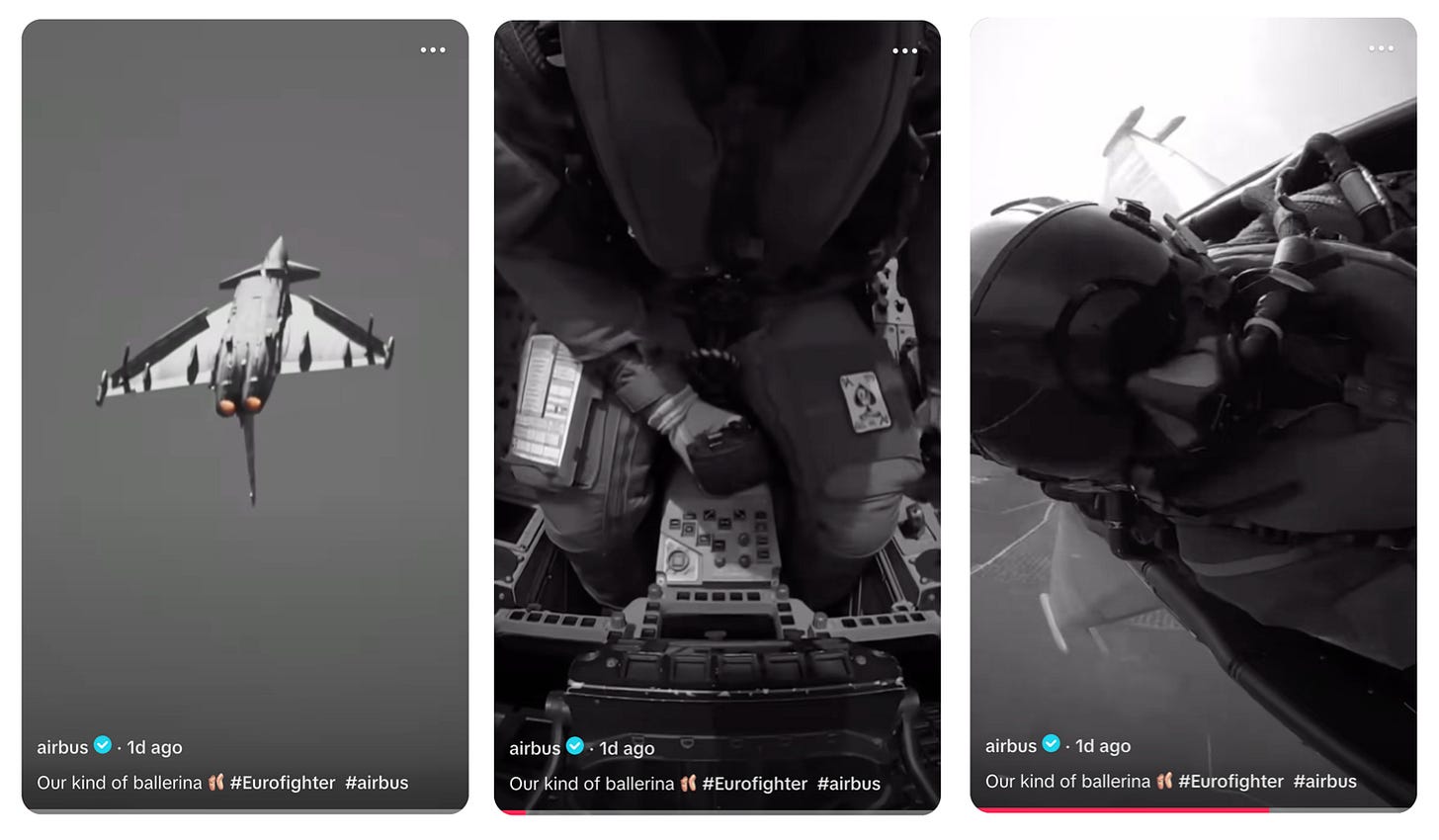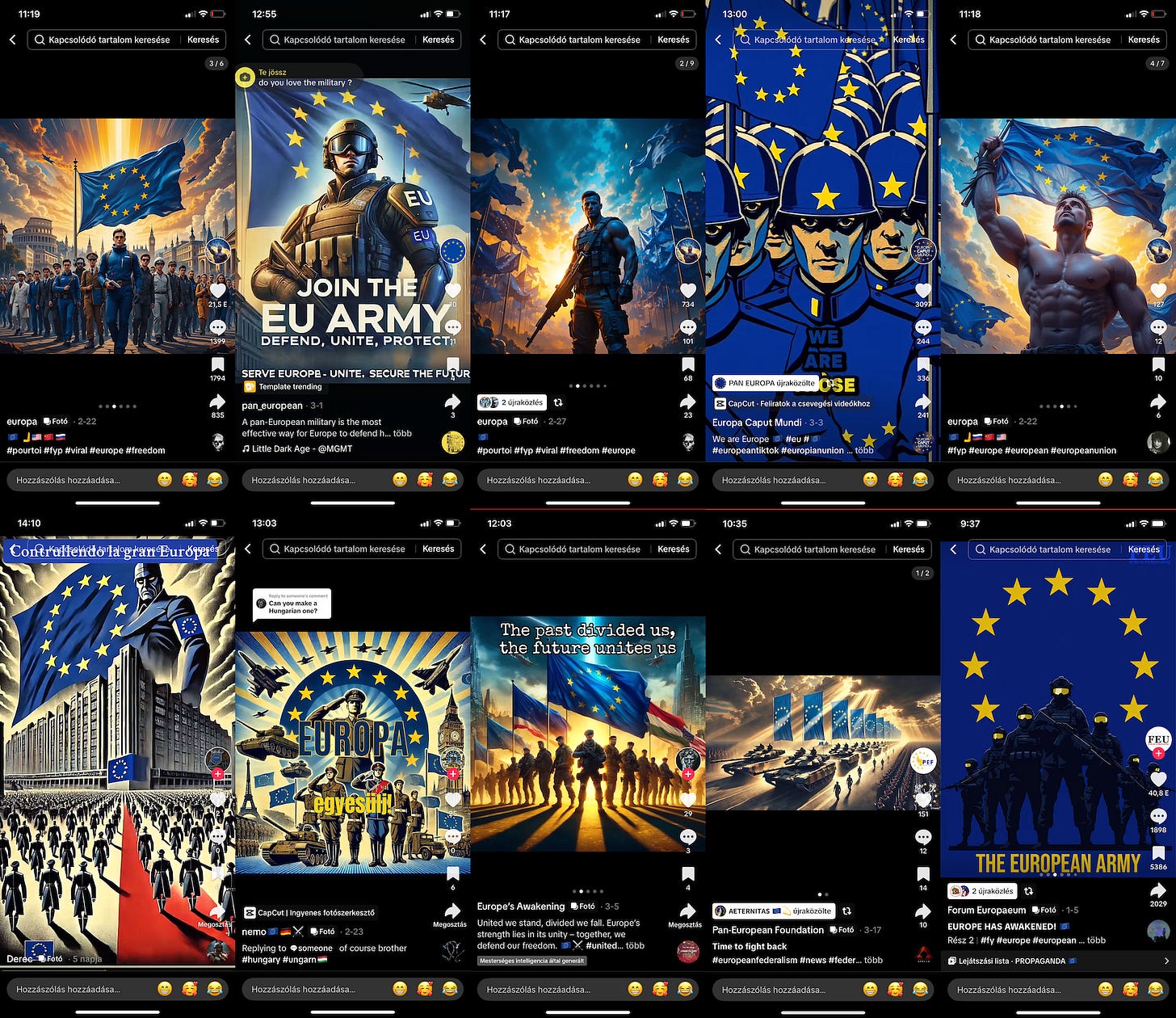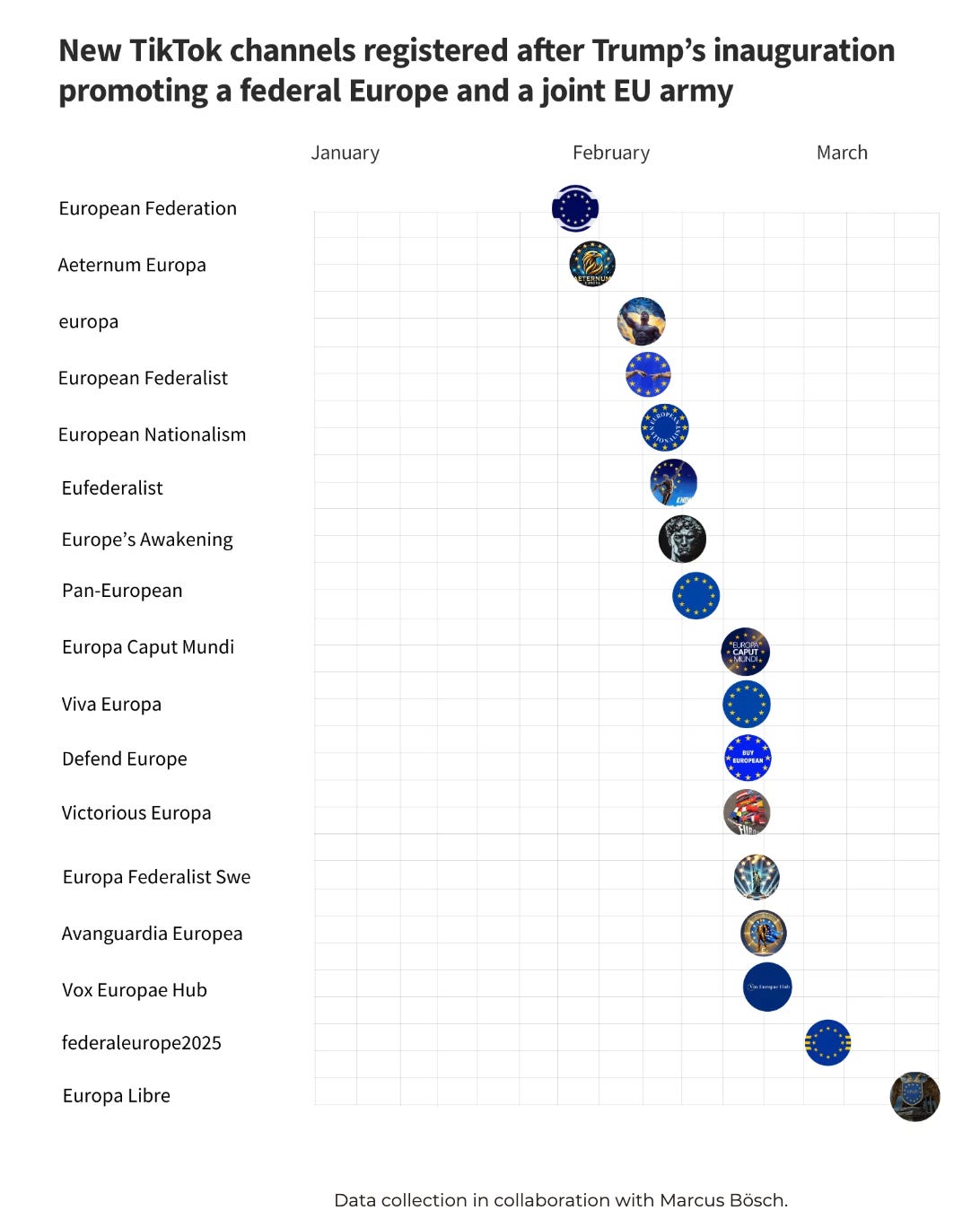Hello.
You are reading Understanding TikTok. My name is Marcus. I am a researcher and consultant. Altogether now we are 8K. Thanks for subscribing! Since March 4th (#140) the techno-fascist (New Yorker) coup (Timothy Snyder) lingers on and “absurd and incomprehensible things keep happening” (Albert Lloreta). Oh, and TikTok was not sold. The deadline was extended for another 75 days as the future of the app is now at the center of a geopolitical tussle between Washington and Beijing. The entire thing is likely to become even more complicated as a trade war between the two countries escalates (The New York Times).
Today we talk about:
🤯 Military Brainrot
🇪🇺 Pan-European Propaganda – again
🪇 Some Work Stuff and Links
🤯 Military Brainrot
Tralalero Tralala. If you have been on TikTok in the last months you have probably come across Italian Brainrot. It refers to a series of brainrot-style AI videos, art and memes that combine animals with objects like planes, coconuts or give them anthropomorphic features, especially legs and feet. An ever weirder variation of German Brainrot (#139).
The videos are typically narrated by a male Italian text-to-speech AI voice rhyming the characters' names with absurd statements about religion or random topics. The memes started in early January 2025 on TikTok with Tralalero Tralala, a shark wearing Nike shoes (Know Your Meme).
As always the “trend” was incorporated by brands, political parties and – in recent times – by actors of the military-industrial complex. Just like other “trends” with the IDF utilizing the Studio Ghibli AI Generator (Know Your Meme) further pushing the limits of military cutefication or the White House where someone embraced ASMR (Know Your Meme) turning government communication further into “gleeful cruelty” (The Atlantic).
Airbus is Europe's largest aerospace and (after BAE Systems) second largest defence company. Airbus has been using trending sounds to successfully promote the company on TikTok. The account (@airbus) has garnered 3.4 M likes. One of the videos shows an A400M-edit. We see video snippets of the Airbus A400M Atlas, a European four-engine turboprop military transport aircraft, edited to Doechii’s viral ‘Anxiety’ song (indy100) – a rather happy song about anxiety disorder.

In another video we see footage of the Eurofighter – a supersonic, canard delta wing, multirole fighter. The video is edited to the Italian Brainrot sound Ballerina Cappuccina – a young woman with a cup of coffee replacing her head who specializes in Ballet. She was Capuccino Assasino's wife, but got divorced after she was brutally cheated on (Brainrot Fandom).
The caption of the Airbus video: Our kind of ballerina 🩰 #Eurofighter #airbus. The Brainrot-reference totally makes sense given the fact that the entire trend gained viral traction with Bombardiro Crocodilo, a military bomber plane with a crocodile face. The male Italian text-to-speech voice here says, "Bombardino Crocodilo, an alligator that bombs kids in Gaza and Palestine and doesn’t believe in Allah and loves bombs."
“We no longer understand the reality around us and live in a state of growing confusion”, writes Albert Lloreta: “It seems that the system of values and certainties in which we grew up is collapsing, but we go on with inertia. We cling to the fiction of normality in our lives and pretend not to see how the strange stain in the sky grows day by day.” Tralalero Tralala.
🇪🇺 Pan-European Propaganda – again
I am still not sure what to make of this. This is how i concluded first observations of Pan-European Propaganda on TikTok in March (#140). Thankfully Szilvi Német (x), a Budapest based journalist, art historian and media researcher took over, did a decent investigation and published this brilliant deep dive. We wrote back and forth a bit, here are some questions and some answers on the topic:
What surprised you the most? And why?
I’ve never seen — or imagined — the European Union like this. Especially in Hungary, there’s a strong tendency to depict the machinery of Brussels as something dull, grey, and overly bureaucratic. There’s even an unspoken rule in journalism: don’t put “EU” in the headline, because no one will click on it. Seeing the union reimagined as a military superpower — clad in bold, militant, high-tech visuals — opened up an entirely new dimension for me.
While working on the article, I reached out to many creators, and what really struck me was how ordinary people are investing time and effort into promoting ideas they deeply believe in — even setting aside nationalist sentiments in favor of a shared European cause. They genuinely want to take pride in being European. To me, that feels like a historic moment.
What are typical audiovisual ingredients of the videos?
My friend and I have this running joke that L’Amour Toujours by Gigi D’Agostino is the unofficial anthem of this European wave. There’s another propaganda track called Make Europe Great Again — an upbeat, anthemic march with strikingly powerful lyrics. It’s really incredibly catchy. After I heard it for the first time, I couldn’t get it out of my head for days. But it's also everything from MGMT’s Little Dark Age to Taylor Swift’s …Ready for It?
Visually, the content tends to fall into two main categories. One is the remake or appropriation of 20th-century agitprop posters, reimagined with the help of AI. Using Midjourney, you can even see these static posters come to life — jets literally fly off the two-dimensional surface.
The other category is entirely new AI-generated imagery. Some of it is made with older AI engines, giving it a retrofuturistic aesthetic, while others are hyperrealistic — almost veering into kitschy, Disney-like territory. Stylistically, the deep blue of the EU flag serves as a unifying thread, tying together this wide variety of images.
Thematically, the building blocks are strikingly consistent: the mythical figure of Europa Invicta, iconic European architecture, the act of planting the EU flag on the Moon, high-tech European trains and rockets, and — most importantly — a unified European army, often portrayed as a kind of modern-day Noah’s Ark featuring a mix of ethnic phenotypes representing different nations. From there, the narrative branches out. Some accounts promote nuclear energy, or the support of Ukraine, while others issue practical calls to action — like urging followers to buy exclusively European-made products.
What is the most interesting from an aesthetic point of view?
There’s been a lot of discussion about how AI-generated imagery seems to naturally align with far-right aesthetics — and I see echoes of that in the pan-European visuals as well. In this trend, nationalism and patriotism appear to shift from individual countries to the continent as a whole. Beyond the glorification of military culture and warfare, these images often project a strong sense of superiority — a kind of continental pride with an unmistakable edge. Others seem to sense that too, as many commenters pointed out the sinister undertones. Users referred to it as “eurofash” (short for euro fascism), evoking uncomfortable echoes of 20th-century authoritarian regimes. They also added that this is definitely not the Europe they want to live in.
How has this “trend” developed?
Many accounts were newly created in late February and early March, following Trump’s announcements and the EU’s rearmament plans. While federalists had been promoting similar ideas long before, now they seemed to have gained renewed momentum and visibility.I’d say it’s still a microtrend — some videos can rack up as many as 100,000 views, but the accounts behind them haven’t yet built a critical mass of followers.
Among the subgenres, there's a distinctly European version of MAGA emerging, rooted in the belief that we're living in a new imperial age. In the U.S., some commentators have described Donald Trump as a modern-day Caesar — and similar narratives are now being adapted to the European context. You see this when figures like Emmanuel Macron or Ursula von der Leyen are depicted as Roman emperors, dressed in togas and crowned with laurel wreaths.
Who is behind it and what is the goal here?
Most accounts are run by individuals who support the idea of a more federal, united Europe — one that can stand up to the Russian threat and act independently of an unpredictable United States. Alongside them are a number of channels operated by small pan-European organizations and media platforms, such as the Pan-European Foundation and Forum Europaeum. The content is largely fan art, often remixed with real speeches from European politicians and references to rearmament plans.
Thanks Szilvi!
🪇 What else – Work edition:
I wrote about Palestinians being falsely accused of engaging in "Pallywood" in November 2023 (#113). Therefore i was happy to be cited in a story by NGO Forbidden Stories – an international network of journalists. New research of Forbidden Stories and its partners have uncovered research from an Israeli NGO indicating that the Israeli X account called Gazawood does practice online disinformation on a massive scale.
VSquare is one of the leading regional voices of investigative journalism in Central Europe. I discussed the German TikTok elections with Josef Šlerka. He wrote a great summary on how TikTok played a crucial role in the election especially for younger generations.
I discussed “Facts, fakes and filter bubbles” with Thomas Laschyk, founder of Volksverpetzer, and Alice Echtermann from Correctiv-Faktencheck, pleasantly moderated by journalist Damla Hekimoğlu for Koerber Foundation in Hamburg recently. You can watch the entire discussion where i try to debunk the whole notion of “filter bubbles” (Video where we all speak german).
In May, I will be teaching two block seminars: "Political Communication on TikTok" at the University of Düsseldorf and "Vertical Storytelling" at the Institute of Journalism at the Hannover University of Applied Sciences and Arts.
More
TikTok is adding Footnotes (Engadget)
Views are nothing. Views are lies. (The Verge)
Lorde (Hypebeast)
Zahide Won This Trend (Know your Meme)
The social media domination of the German far right (ECDA)
News #foryou on TikTok: A Digital Methods-Based Study (Journalism & Mass Communication Quarterly)
Thanks for reading. If you want to discuss TikTok, need consulting, feedback on your account or want a keynote. Come say ‘Hi’.






